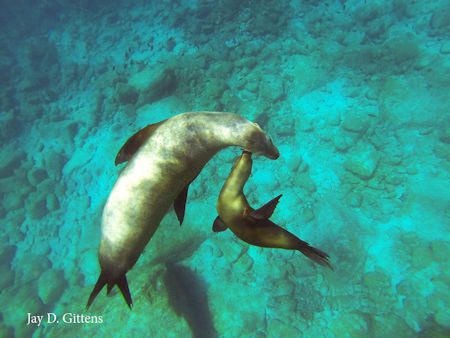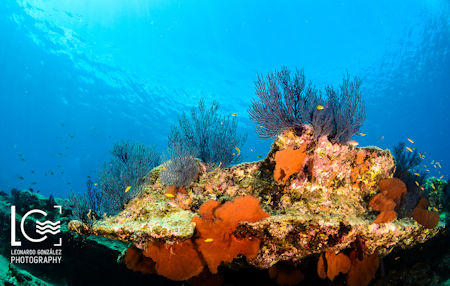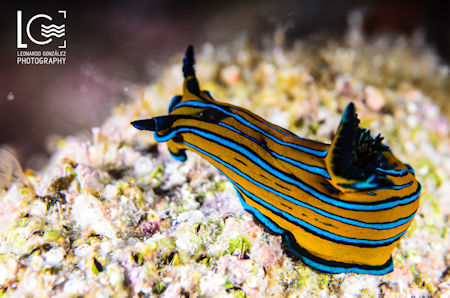 |  |
By Jay D. Gittens

Our vessel sets off out of Marina de La Paz in the city centre. The Espíritu Santo Archipelago soon appears as a single mass set on the horizon of the varying shades of blues and greens characteristic of the Sea of Cortez. What’s in fact an island group is not too far from the shore of this relatively small city which lies around 2 hours’ drive north of Los Cabos. Depending on sea and weather conditions, the boat ride is an hour to an hour and a half to reach the northern-most point, “Los Islotes”. These rocky islets are home to a colony of California sea lions, one of the archipelago’s most popular tourist attractions.
On this particular early morning, the bay is as flat calm as a pond on a windless day and has that glassy look about it that makes one want to jump right in. Of course there will be days when conditions are not so favourable. If the wind speed is forecast to be 10 knots or more, consider choosing an alternative day for your visit, particularly if choppy seas make you feel queasy. For the most part, conditions here in La Paz are well within comfortable limits for most visitors.
As we head north out of the bay, the first of La Paz’s beaches lay on our starboard side. In order these are “El Coromuel”, “La Concha” and “El Caimancito”, each contributing to the striking contrast of colours and textures symbolic of the transition zone between the Baja desert and the Sea of Cortez. On occasion, dolphins and whales can be seen cruising close to the shore here and it’s a good place to spot schools of mobula rays. A little further on are two of La Paz’s most popular beaches for locals and visitors alike; Ballandra Bay and El Tecolote. Once we pass the latter, we move into the channel between the Baja peninsula and the island group.

Glancing down from the boat’s bowsprit, I observe how the bow effortlessly slices through the surface of the sunrise-tinted ocean and I begin to feel the excitement of connecting once again with one of my favourite places on the planet. With a little time and distance, the city of La Paz begins to blend into its mountainous background until it is no longer visible. Looking in our direction of travel some features of this uninhabited island group begin to take shape and come into focus.
Born partially of tectonic uplifting sometime during the Pleistocene epoch, the land area of the Espíritu Santo Archipelago covers a little in access of 100 square kilometres. The tectonic activity is quite evident in some of the amazing rock formations. Proof of ancient volcanic events is also apparent, expressed as exposed layers of ash and lava that form blackened streaks stamped into the history of the prehistoric rocks.
The marine protected area (MPA) of the archipelago is markedly larger than the land component, spanning almost 600 square kilometres. This area was declared a National Park in the year 2007 and includes a nine square kilometre area around a seamount known as “El Bajo”, 20 minutes north-east of Los Islotes. Divers are drawn from all over the world to this site for the chance of hammerhead shark and Pacific giant manta encounters. Prior to the National Park statute, Espíritu Santo was declared a UNESCO Biosphere Reserve and World Heritage Site in 1995.
Our boat reaches the first island of the archipelago, Isla Espíritu Santo itself. Progressing up the west side we quickly come to Bahia San Gabriela, a large sheltered bay that is home to a huge rookery of magnificent frigate birds. Looking up into the cloudless sky, there’s hundreds of individuals gracefully circling overhead, using their long sharp wings and scissor-like tails to effortlessly ride the wind. We creep slowly into the bay and head towards the main rookery area to snap photographs and observe the behaviour of some of the birds. There must be in access of 1000 breeding pairs here. Other bird species in the area include blue-footed boobies, ospreys, great blue herons and pelicans. We soon continue on north, next destination - Los Islotes.

After an hour or so, our boat arrives at the sea lion sanctuary of Los Islotes. I am delighted to see we are the only group here. The barks and groans of the sea lions echo off the jagged rocks as individuals negotiate over hauling-out space. As we anchor to one of the buoy lines, two juveniles swim around our boat in playful anticipation. I quickly don my mask, snorkel and fins and slip into the warm water taking note of the clear visibility today. It’s time to play with the sea lion pups. I call them sea puppies since their behaviour is almost identical to that of an actual puppy.
Swimming with sea lions is an amazing experience. Whilst they may appear rather clumsy on land, in the water they are agile, graceful swimmers. Once they realise you’re not a threat, the juveniles can become very confident. Typical behaviours include swimming in rapid loops around you and hanging upside down in the water column, all the time looking at you with their puppy-dog eyes. Very often they will swim towards you and blow bubbles and on occasion, if you extend a clenched fist, they may nibble at it playful gesture. The mothers of the pups are never too far away and will occasionally join in the fun. More often than not they just prefer to watch over their offspring from a few feet away. The bulls tend to stay out of the way but are very territorial and protective over their harem of females. There are rules to be noted when interacting with this species such as not getting too close to the rocks.
From the sea lion rookery of Los Islotes, our group head back south and pull into Bahia Ensenada Grande. As the name suggests, it’s a large bay and it is situated on the west side of Isla Partida. We are here to finish off the trip with a ceviche lunch on the beach and some rather fine snorkelling. Many reef fish species can be found here including parrotfish, angelfish, groupers, sergeant majors, rainbow wrasse, bannerfish and butterfly fish. After some exploration and a good lunch, it’s time to head back to the city.

Though just off-shore of the capital city of B.C.S., the Espíritu Santo Archipelago gives the impression that you are far separated from civilisation and the bothers of regular life and this is something that draws visitors to return year after year. While it may be difficult to experience all that the islands have to offer in just one day, it’s sufficient to get a good grasp of why so many people find Espíritu Santo so enchanting. If you have more time in your schedule, an alternative to a day excursion is to embark on one of several multi-day adventures on offer such as camping, kayak expeditions or a liveaboard diving trip.
You can contact me directly for information about trips to Espíritu Santo.
Email: jaydgittens(at)gmail.com
Cell phone: +52.612.197.5824
References:
Comisión Nacional de Áreas Naturales Protegidas (CONANP)
Hausback, Brian P. "Cenozoic volcanic and tectonic evolution of Baja California Sur, Mexico." (1984)

Rigo at the office has been so supportive and awesome, both on e-mail and by telephone. He helped...

Great company, great prices, and even better customer service. We've lived in Baja for 7 years and...

I can't think of an easier way to get Mexican insurance; just one call on my departure day and I...